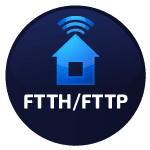Fibre Internet – How it works

How does Fibre internet work?
You may associate the roll out of Fibre networks in your area as a process that led to trenched pavements and lumpy driveways for a short while… before the beauty of faster internet entered your home.
Although it arrived in a whirlwind, this form of internet connection has now become a necessity for most, especially considering the growth in businesses turning to remote since 2020. Furthermore, since most modern devices depend on a stable connection for use, fibre internets’ unmatched speed and reliability has turned it into a huge success.
Though the real question is how does fibre internet work? We’re here to tell you how!
How does Fibre work?
Fibre internet makes use of fibre-optic cables to establish its connection instead of traditional copper wires. These cables have a lower distortion level than their traditional alternative, which means that they are better at transmitting as well as carrying data. In turn, overall speed and bandwidth improves.
Another main difference we see in the use of fibre-optic cables is that it makes use of light, instead of electricity, for this higher bandwidth capability. These cables are made of smaller, extremely thin optical fibres which consist of a core and cladding. Each cable has the potential to carry hundreds of these strands.
The core, the innermost part, is where the light is able to travel while the cladding is wrapped around for protection. Together these two parts are combined to create an internal reflection which is what allows the light to travel without escaping.
The light pulsing through these cables hit the glass cladding at an extremely shallow angle which enables a mirror like reflection. This reaction is encompassed through the cladding as it carries a different optical density to that of the core.
When the light pulses reach their final destination, the optical network terminal turns it into electrical ethernet which facilitates the internet connection. The light sent through these cables also effectively sustain and carry binary data which is how the connection maintains high stability.
How does installation work?
Whether you have already had fibre installed in your area or not, chances are good that you have witnessed the construction involved and cables being laid into the open trenches.
When fibre rollout is approved for an area, the first step is to install a fibre ring. This is what feeds fibre into your area from a central distribution hub. After this, the trenching begins in order to install all necessary fibre-optic cables to link to this central distribution, to ensure that the connection runs successfully once set up.
After the “nitty gritty” of the outdoor installation is complete, you may choose a suitable service provider to install an ONT (optical network terminal) and a fibre compatible Wi-Fi router in your home.
Our partner in fibre installation, Lightstruck, details their installation process as follows:

Once your area has had fibre-optic cables installed, a technician will connect the cable running in your street to a device called an ONT (optical network terminal) inside your home.

After this is done your fibre line is activated.

Thereafter, you will need a compatible wireless router to plug into your ONT in order to activate your connection.

Once your router is set up, and your service provider has activated your internet, you will be ready and connected!
Types of optical fibre

Single mode:
This optical fibre has a very thin core that is typically 5 to 10 microns in diameter and has the capacity to carry only a single mode of light. By decreasing the light pulses that travel through the core, attenuation is slightly lowered which allows the signal to travel further.
This is typically suited for television, internet and telephone signals.

Multi-mode:
This optical fibre is bigger than the single mode fibre, which allows several modes of light to travel through it in different paths. This allows more data to be transferred through a shorter distance.
These are typically used for activities such as linking computer networks.
Different kinds of fibre connections

Fibre to home/premises
This fibre connection means that connection itself is pulled straight onto your desired premises. This is the most common manner of setting up home connections in South Africa.

Fibre to desktop
This fibre connection allows the fibre internet to be directly connected to the user’s desktop for a pure connection.

Fibre to curb
This fibre connection is created outside your premises typically at the nearest pole or utility box. Following the FTTC installation, coaxial cables are able to send signals into your location. This is done by using both fibre-optic cables and copper wires.

Fibre to node
This fibre connection provides a stable connection to those within a certain radius of the node itself. The connection from the node into your home is generally made with existing DSL lines.

Fibre to building/basement
This fibre connection allows for a connection to be brought to the building itself before being distributed throughout the building with copper wiring.
Get connected fast with Yutiliti
If you noticed fibre being rolled out in your area but have not set up a connection in your home just yet – we can assist. Although nothing is as fast as our fibre, we will have you set up and your admin done in just 10 minutes. A couple of days later you will be ready to connect to the internet at newfound lightening speeds!
We hope you are not still wondering ‘how does fibre internet work?’, though if you are maybe it’s time to check out its unmatched speed for yourself.
Don’t have fibre in your area just yet? Not to worry. Simply express your interest with us for the process to start.





